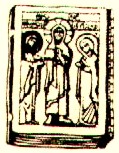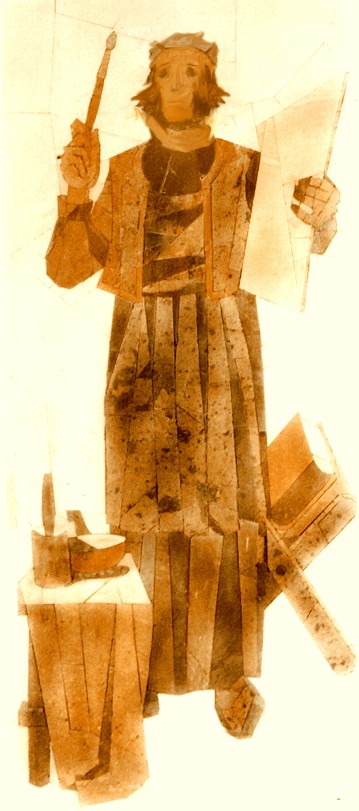
T‘OROS ROSLIN [1216-1288]. THE MOST PROMINENT MASTER OF THE
ARMENIAN ILLUMINATION OF THE MIDDLE AGES. THE LEADING
LIGHT OF THE CILICIAN SCHOOL.
MASTERS OF THE ART

T‘OROS
ROSLIN [1216-1288]. THE MOST PROMINENT
MASTER OF THE
ARMENIAN ILLUMINATION OF THE MIDDLE AGES. THE LEADING
LIGHT OF THE CILICIAN SCHOOL.
Written by Gevork Nazaryan
Armenian miniatures of Illuminated manuscripts are one of the most beautiful and unique pages of Medieval Christian art. The history of Armenian illumination began during the Golden Age of Art and Literature in the Vth century. Early Armenian miniatures are remarkable for their festive grandeur, they make one feel the infinitive power of art and the universality of its language.
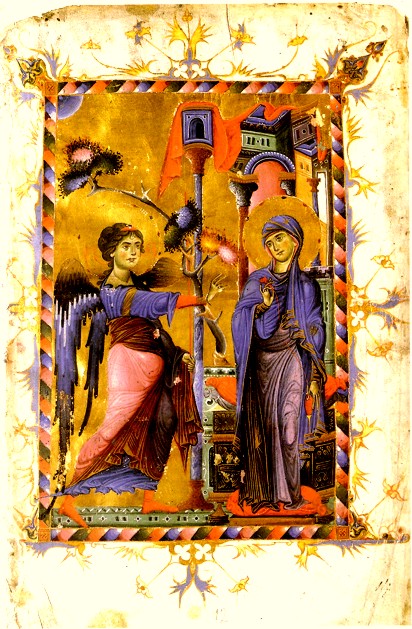
GOSPEL ILLUMINATION [1280]. MATENADARAN MS NO. 9422
BY THE GREAT
T‘OROS
ROSLIN.
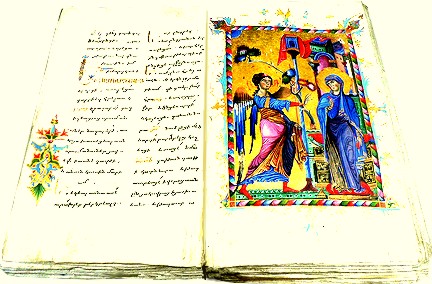
The illuminations demonstrate continuity and link from the earlier pre-Christian period from the frescos and relieves of the kingdoms of Mitanni and Ararat - an early period of Indo-European tradition and symbolism of Fertility and Light -- incorporated and continued in the richness and colorful palette of Armenian illuminations during the Christian period.
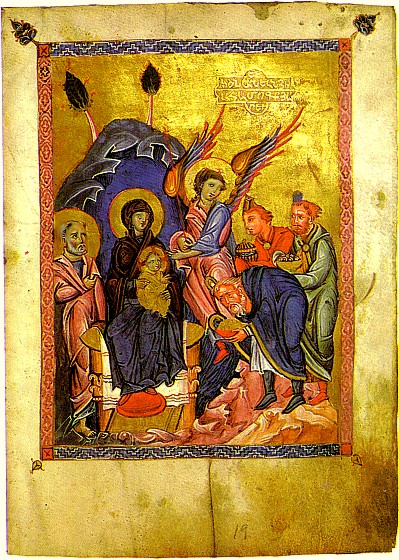
GOSPEL OF MALAT‛YA
[1267-68]. MATENADARAN MS NO. 10675 P 19a.
BIRTH OF THE SAVIOR-- VISITATION OF THE THREE MAGI
BY
T‘OROS
ROSLIN.
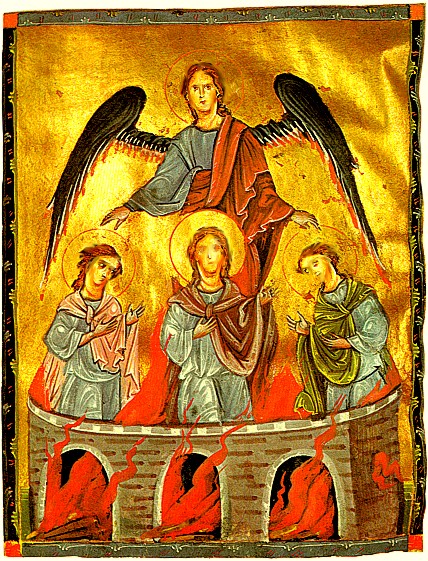
FIERY FURNACE (SHADRACH,
MESHACH, AND ABEDNEGO) [1266], MASHTOTS.
MATENADARAN MS NO. 2027, FOL. 14 V. BY
T‘OROS
ROSLIN
DONE IN
HROMKLA - THE SEAT OF THE ARMENIAN CATHOLICOSATE FROM 1151
TO 1441 - WHERE ROSLIN WORKED AND CREATED MOST OF HIS
MASTERPIECES.
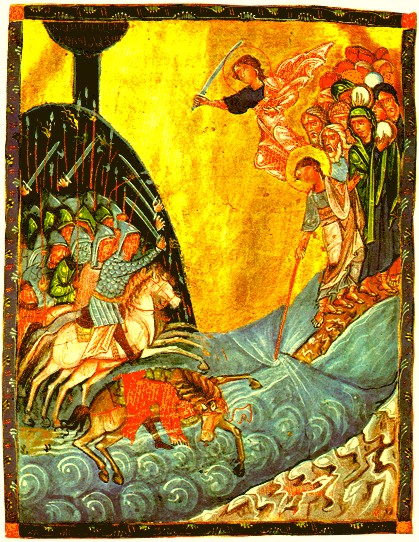
THE PASSAGE OF THE RED
SEA, MASHTOTS [1267]. MATENADARAN MS NO. 2027.
BY
T‘OROS
ROSLIN.
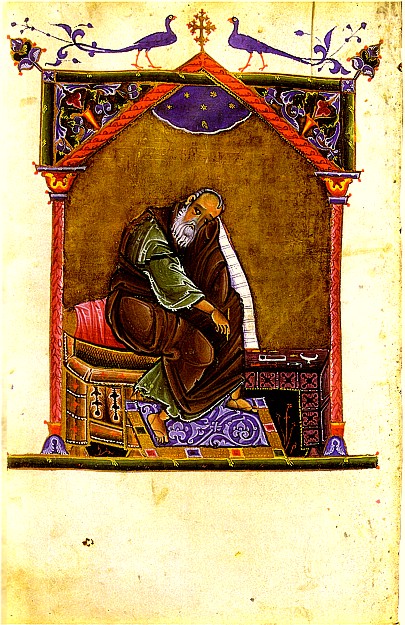
ILLUMINATED MANUSCRIPT BY T‘OROS
ROSLIN.
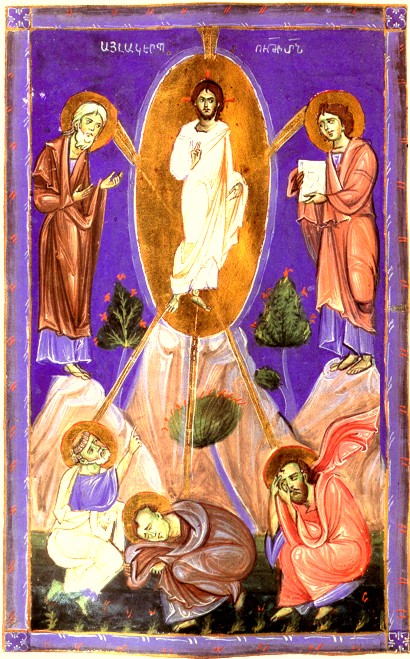
GOSPEL OF PRINCESS K‛ERAN
[1265] BY THE GREAT ILLUMINATION ARTIST
T‘OROS
ROSLIN. INLAID GOLD LEAFS ON NEON BLUE
BACKGROUND
SIX RAYS LEAD TO THE CENTER [SEVEN] CHRISTIC SALVATION.
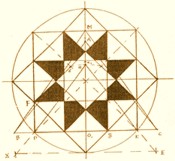
BRILLIANT ILLUMINISTS LIKE
ROSLIN
[ROSLYN]
INCORPORATED SACRED GEOMETRY INTO THEIR WORKS
AS THE UNDERLYING TRUE ESSENCE OF THEIR GREAT WORK...
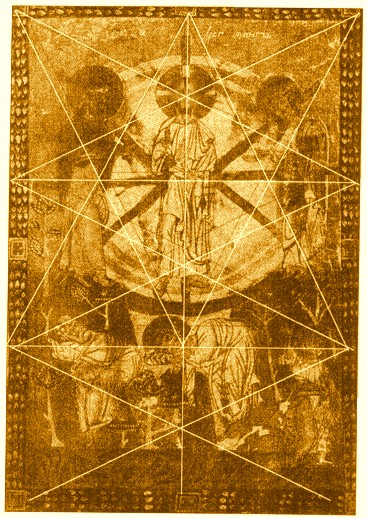
FROM THE PLEROMA [THE SOURCE] EMERGES GOD-MAN WHO HAS
ACHIEVED CHRIST CONSCIOUSNESS [JOHN THE BAPTIST AND MARY
COMPLETE THE HOLY TRIUNE]...THE EIGHT-FOLD PATH IS MARKED
AND FORMS THE HARMONIC COMPOSITION OF THE ILLUMINATED
MANUSCRIPT.
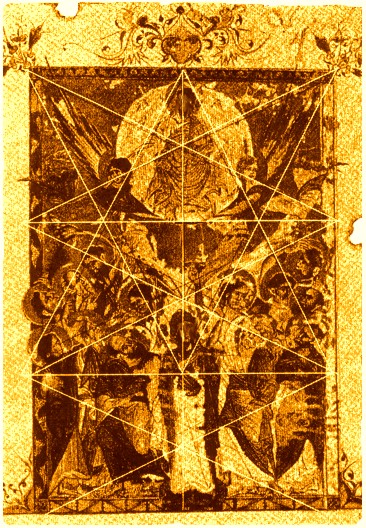
KARLEN AVETISYAN FOR MANY YEARS STUDIED COUNTLESS ANCIENT
ARMENIAN ILLUMINATED MANUSCRIPTS OF THE MASTERS OF MINIATURE
PAINTING AND WAS OVERWHELMED TO FIND DEEP UNDERSTANDING OF THE LAWS
OF SACRED GEOMETRY AND NUMEROLOGY ENCODED [VISIBLY, THAT IS THE
GEOMETRIC MOTIFS, VEGETATION-FERTILITY SYMBOLS, TREE OF LIFE, SACRED
BIRDS IN THE MARGINALS, XORANS, BORDERS AND MORE SUBLIMELY... INVISIBLY]
INTO EVERY SINGLE ILLUMINATED PLATE BY MASTERS LIKE
TOROS ROSLIN AND SARKIS PICAK.
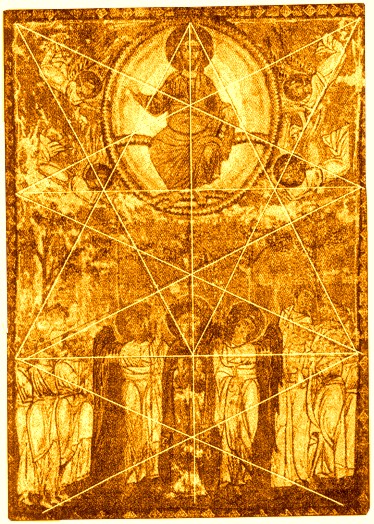
CHRIST WITHIN THE COSMIC EGG [WHOLENESS]. NOTE THE VERTICAL
LINE RUNNING ACROSS [EVENT HORIZON] THE RAYS EMANATE FROM
THE GODHEAD [AURA] OF THE VERY SOURCE/PLEROMA...JESUS THE MAN
[REP. WITH THE SQUARE UPON MATTER/MOTHER] IS TAKEN UP BY
TWO FLANKING ANGELS TO THE SYNTHESIS-TRIUNE
[GOD THE FATHER...DIVINE SPARK OF THE CREATOR REP. BY THE UPWARD
TRIANGLE POINTING/LEADING TO THE AURA/ETERNAL FIRE...]...12
DISCIPLES
OF CHRIST ASSOCIATED WITH THE 12 [DUODECIMAL] STEPS OF GODHOOD
[12 HOURS OF DAY AND 12 HOURS OF NIGHT, 12 HOUSES OF THE
ZODIAC, 12 MONTHS OF THE SOLAR YEAR ON AND ON...]
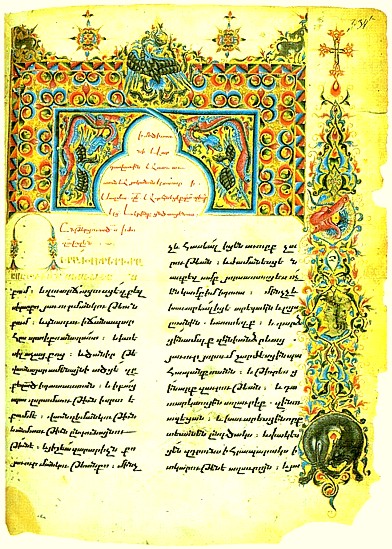
AN ILLUMINATED MANUSCRIPT. THE CENTRAL PORTION MANIFESTS
THE TRIUNE WITH TWO FLANKING DRAGONS AND EAGLES FACING EAST AND WEST
THE PHOENIX OF NEW LIFE WITH TWO EIGHT POINTED STARS ABOVE.
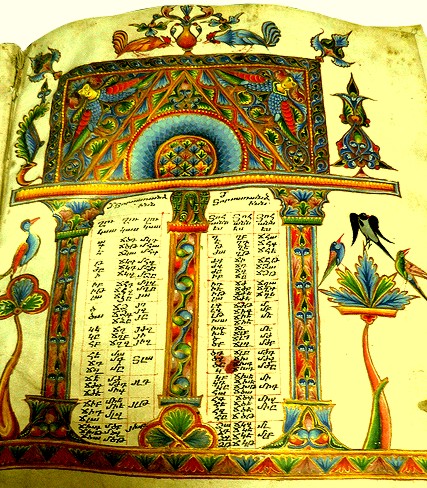
SACRED GEOMETRY, FERTILITY SYMBOLS, VEGETATIVE AND ANIMAL SYMBOLS
-
SPHINXES WITH RICH COLOR AND GILDED PLATES ARE THE QUINTESSENTIAL
COMPONENTS OF ARMENIAN ILLUMINATED MANUSCRIPTS. THE TREE OF LIFE,
STEMMING FROM THE SACRED VESSEL OF GOD UPON THE THREE PILLARS OF
THE UNIVERSE....ADORNED WITH SPIRALING SYMBOLS IN VIVID GREEN, BLUE
AND RED. SACRED ANIMAL-TOTEMS AND PLACED IN THEIR ACCORDING PLACES
LIKE THE TWO ROOSTERS OF DAWN AND NADIR FACING THE SACRED VESSEL
WITH THE BRANCHING TREE OF WISDOM THE RADIATING SUNBURST WITH THE
DARKER [INWARD] TO LIGHTER [OUTWARD] TONES IN THE
FORM OF A HOLY TOROID [BOLORAKN] ARE CAPPED BY TRIANGULARLY
ALIGNED SMALLER TRIANGLES FACING DOWN AND UP [WATER AND FIRE] WHICH
ALONG WITH THE COMMON THEME OF POMEGRANATES AND GRAPES GOES TO THE
EARLIEST ARMENIAN SETTLED COMMUNITIES AS CIVILIZATION BEGAN TO
TAKE SHAPE IN ARMENIAN HIGHLAND THANKS TO THE NEOLITHIC REVOLUTION.
THE MOTIF OF POMEGRANATES AND GRAPES AS THE TREE OF LIFE WAS SUPREME IN
ARMENIAN KINGDOMS OF MITANNI AND ARARAT [VAN-URARTU].
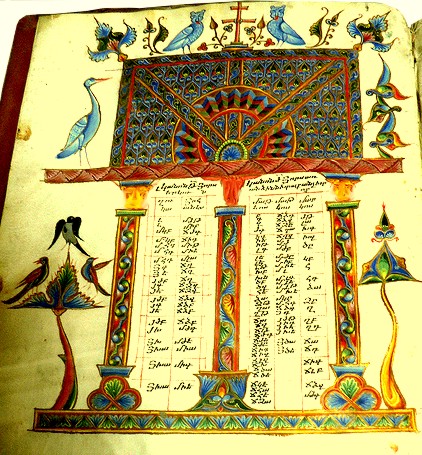
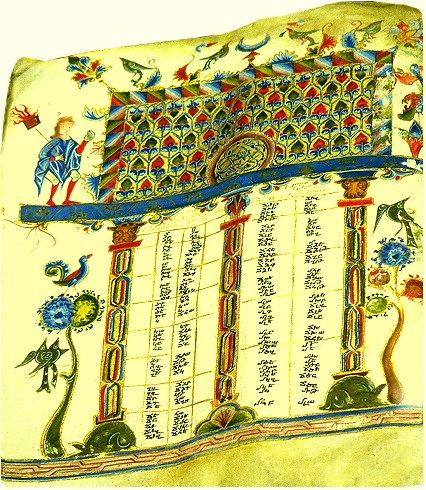
The tradition of manuscript illumination established at a very early date required a particular layout in which the main text was preceded by the xorans. The obvious architectural prototypes of xorans go back to late antiquity. These decorations in the introductory folios of Armenian manuscripts, conceived, as a kind of entry to the Gospels was not accidental: the columns of this symbolic arch enclosed the Canon tables, which were supposed to confirm the authenticity of the four Gospels.
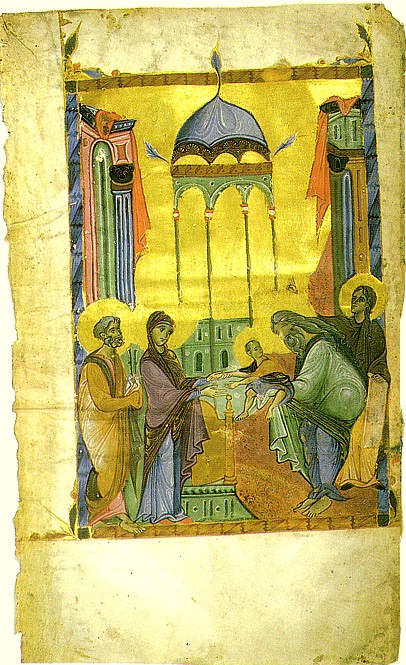
Headpieces of Eusebius' Letters to Carpianus might include portraits of either or both. The introductory folios with the Canon tables and the Letters, were usually followed by a cycle of full-page illuminations whose composition depended upon the date and origin of the manuscript, as well as to the theme of the manuscript (mostly Christian theistic scenes).
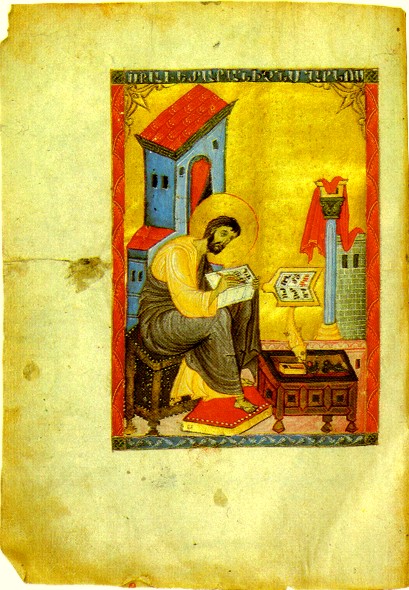
GOSPEL MATENADARAN MS NO. 7648 P. 82b. XIIITH CEN.
Early manuscripts were colored on paper and as well as parchment. One of the most expensive and widely accepted red dyes that were used by Armenian illuminators was the famed, beautiful and colorful, bright red Vordan Karmir [lit. Red Worm] ink [from the Ararat Valley] that was exported upon a substantial demand by the kings, emperors and prelates of the ancient world [the ink was primarily used by kings and emperors for the royal red seal that was affixed to important documents and treaties].
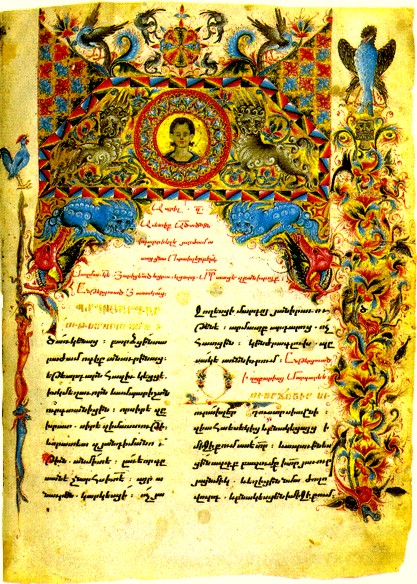
ILLUMINATED MANUSCRIPT. ALLEGORICAL SYMBOLISM ABOUND.
The famed object of Armenian illumination were scenes from the Bible, including; The Annunciation, the Nativity, the Baptism, the Crucifixion, the Ascension, the Descent of the Holy Spirit and of course many other similar theistic themes. The four Gospels followed the pictorial cycle; each of them proceeded by an image of the Evangelist, with a decorative headpiece on the opening page.
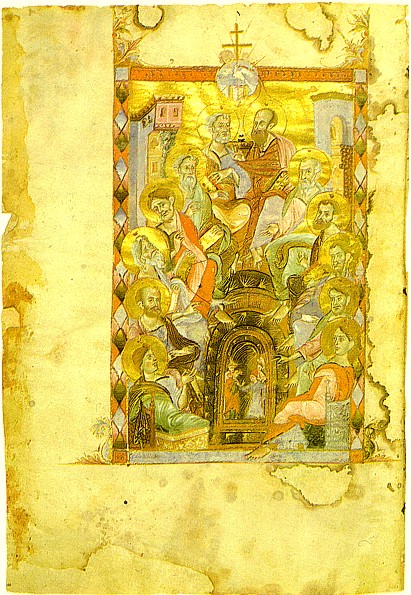
Manuscripts in of the XIIth to XIVth centuries have a certain artistic unity in their main features. It was in this period that illumination developed into book illustration of its own, however it still remained close to the conformed rules of manuscript illumination. The designs in the manuscripts of this period form many of the headpieces, ornate initials and marginal decorations. A certain balance is established between the narrative and the purely ornamental décor. The mid-XIIIth-century Cilician school is unique in the brilliance of illumination [including the application of golden sheets that were affixed to the manuscripts].
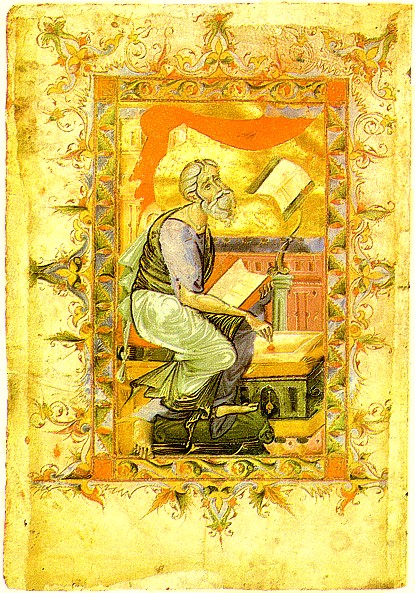
MATENADARAN GOSPEL [1287] NO. 197. MATHEW THE APOSTLE. P. 136.
For masters of Cilician school an illuminated Gospel manuscript has value, both religious and aesthetic. The Cilician illuminations form a complete entity. Large schools of illuminations were set up next to churches, monasteries and cathedrals in the Cilician Kingdom of Armenia. Scribes, binders and illuminators worked as a concordant team. Often many masters of illumination were experienced in all of the three spheres of manuscript forging.
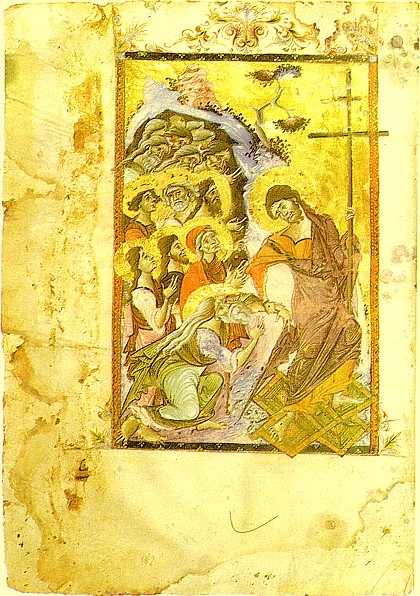
A case in point is one of the greatest and outstanding illuminators of his time, T'oros Roslin, who is also a very gifted calligrapher.
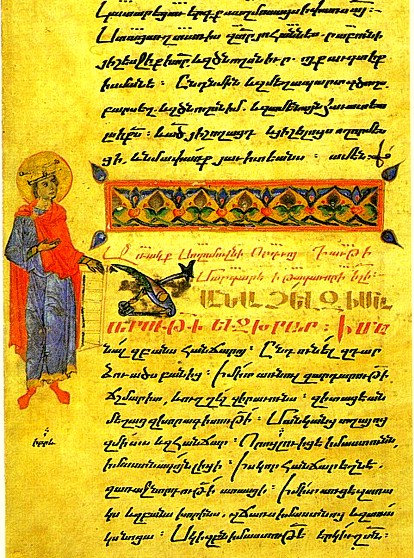
ANOTHER MANUSCRIPT FROM T H E C I L I C I A N
S C H O O L OF ILLUMINATION
Roslin's almost life like, realistic manuscript show signs of early proto-Renaissance which began in Cilician Armenian much earlier than in other parts of Europe. Parallel and emulator of to the Cilician school was the Van-Vaspurakan [Greater Armenia] school of illumination. In the Van-Vaspurakan school, the main accent was on the narrative, mostly from the passages of the Gospel. To this end, the Vaspurakan manuscripts have a sharp contrast with that of Cilicia.
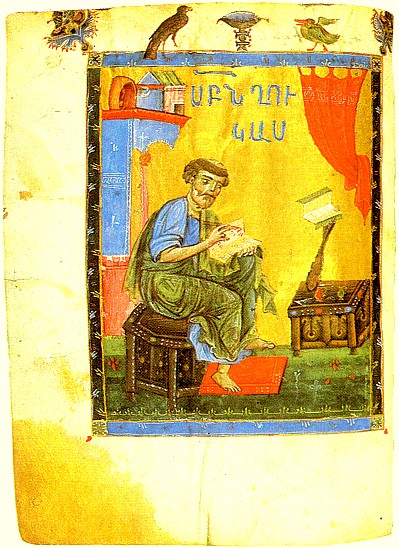
MATENADARAN ILLUMINATED MS. GOSPEL OF LUCAS. P. 158b
Although there were several branches within the school, they were all united by an archaic iconography, full-page illustrations, a linear treatment of ornamental sheets and a common technical and artistic repertoire. In contrast with the Cilician manuscripts with their varied and brilliant colors, on paper and fine parchment, with an ample use of gold, the Vaspurakan School greatly preferred the use of two or three principal color setting correlation against a vellum background. Time and place also affected portraits of the Evangelists in Armenian Gospels.
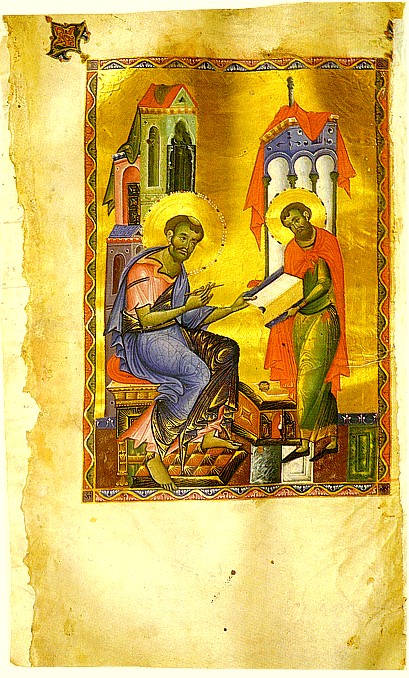
A whole range of types including an ancient scholar, an aristocrat, an ascetic-looking monk and a village philosopher appear on the pages of Armenian Gospels during the thousand year period of Illuminated manuscripts. Another distinctive trait of Armenian manuscript is the hišatakaran [colophon] at the end of the book, which gives the names of the scribe and illustrator, the owner of the manuscript, or the person who commissioned it. As colophons also recorded the provenance or details of the making of the book, they make it possible to classify manuscripts by origin, to date them, to discover new names of artists, etc. Hišatakarans also recorded important events and commemorations, which makes them a valuable source of historical data.
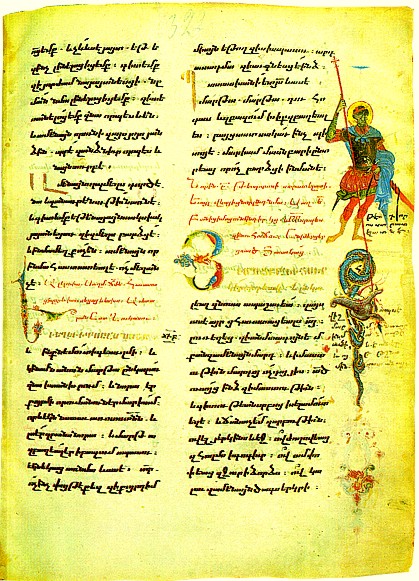
AN ILLUMINATED MANUSCRIPT OF ST. G E O R G E S L A
Y I N G T H E D R A G O N
Apart from the Cilician and Vaspurakan schools there are also the Crimean school (from the large Armenian colony from the great city of Ani, in Greater Armenian and as well as settlers from the Cilician Armenia) the Siwni school (also known as the Tat'ev school, from the distinguished monastery of Tat'ev in the powerful province-kingdom of Siwni.
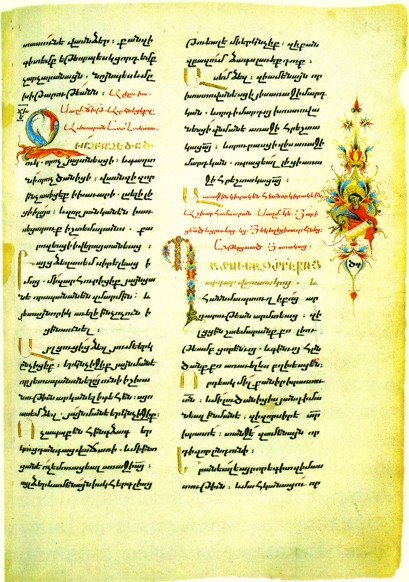
CHASHOTS [1286]. MATENADARAN MS NO. 979 P. 296a.
The forcible Siwni province was one of the cultural and as well as political centers of Ancient Armenia. In cities, fortresses, and monasteries of Siwnik' large libraries stored thousands of precious illuminated manuscripts. During a raid by nomadic Seljuk Turks in the XIth century more than 10,000 manuscripts and scriptures were burned in the Library of Tat'ev at the hands of the nomads.
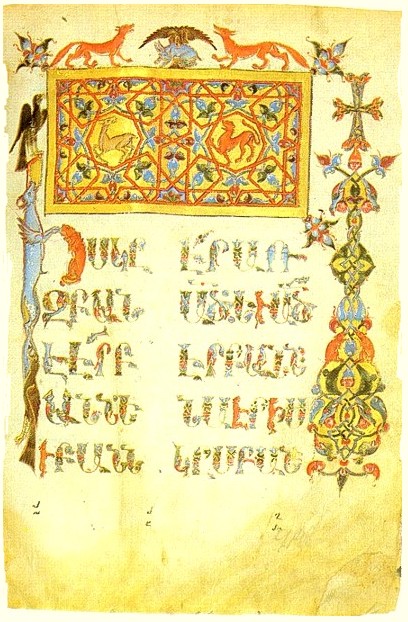
GOSPEL MATENADARAN MS NO. 7648 P. 228a. XIIITH CEN.
The library was carefully rebuild and once again culture and art prevailed over Turkic barbarism that cared little for preserving or progressing civilization. The first Armenian printed book appeared in Amsterdam in 1512. After that printed books began to spread rapidly and eventually ousted the more expensive and luxurious manuscripts. In the XVI the century Armenia was conquered and divided by the Ottoman Turkey and Safavid Iran.
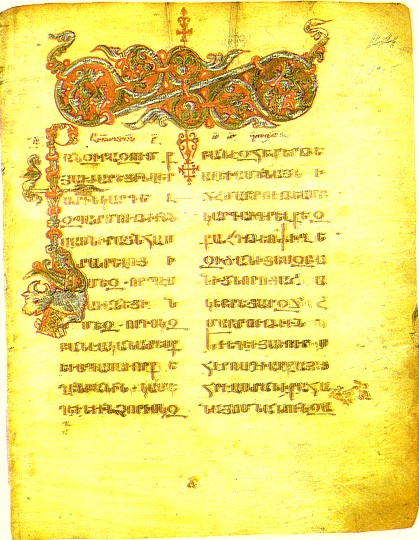
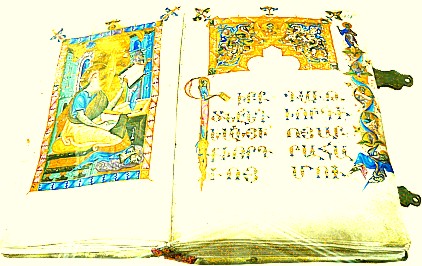
Armenian Culture, especially in Western Armenia and Cilician Armenia under the yoke of the Turkic chiefs suffered a great setback. It was not until the early XIXth century, after the liberation of Eastern Armenia -- that Armenian culture as a whole once again began to regain its lost prestige and eminence in the cosmopolitan unison.
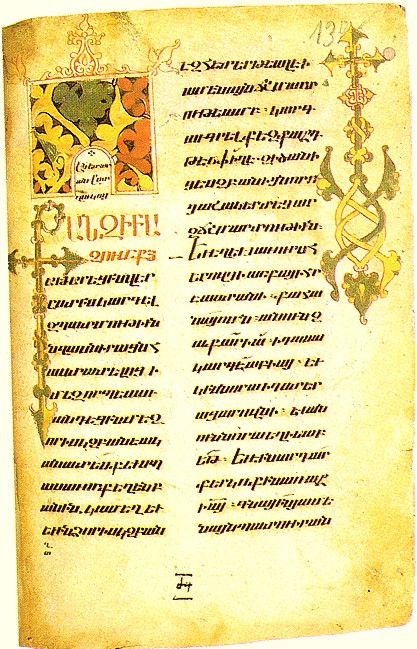
Amidst all the troubles and miseries of life, in the time of wars, enemy raids and religious persecution, for the Armenian nation an Illuminated Manuscript, written in the Armenian Mother Tongue became the symbol of fortitude, vigor and vivacious spirit of preservation and love for and continuation of culture and knowledge.
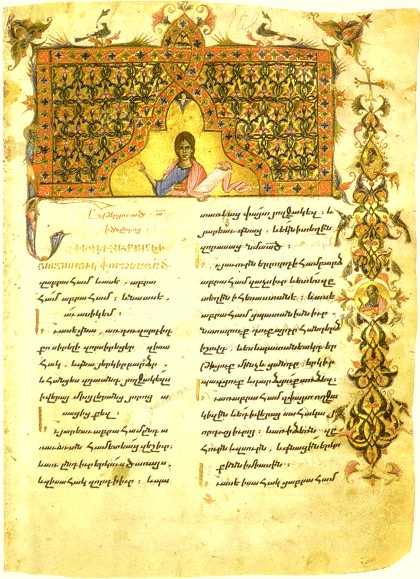
CHAŠOC‛ MATENADARAN
MS NO. 979. P. 158a.
NOTE THE HORIZONTAL POLE GOING THROUGH THE VULVA [WOMB]
[H]AYR WITHIN [M]AYR. TWO BIRDS [DUALITY] FACING EAST AND WEST ABOVE.
THE TREE OF LIFE ON THE RIGHT MARGINAL.
It was this great concern and Armenian love for wisdom that led to the survival of the cultural wealth. Many valuable manuscripts through the centuries of foreign domination, through disastrous wars, massacres, and religious persecutions.
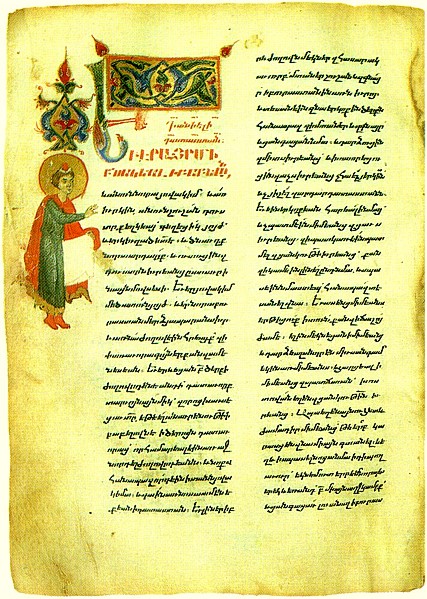
Currently, the largest collection of Armenian Manuscripts is in the capital Yerevan -- at The Matenadaran -- the Depository and Institute for the Preservation and Study of Ancient Manuscripts -- here many of the ancient Armenian and as well as ancient classical works and translations from around the world are kept, studied and published by a team of distinct scholars. The Matenadaran today has a collection of 16,000 manuscripts, 2,500 of them being illuminated.
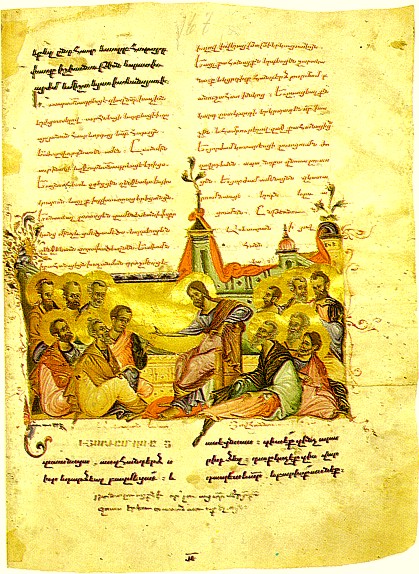
The second largest collection of Armenian illuminated manuscripts is stored in the depository of St. James, in the Armenian Quarter of Jerusalem, of the Patriarchate of Jerusalem of Armenia's Holy Apostolic Church. Impressive collections have been also assembled in Venice, London, Paris, Vienna and in many different cities in the United States.
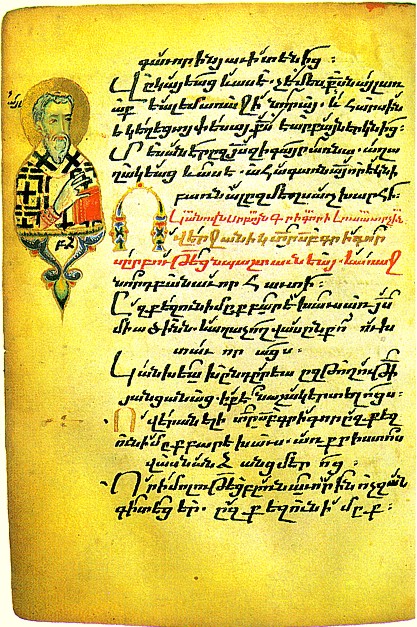
ŠARAKNOC‛. MATENADARAN MS NO. 10439.
MARGINAL ILLUMINATION OF
ST. GREGORY BY SARGIS PICAK. P. 1576.
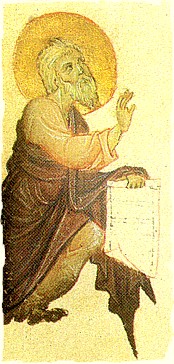
The University of California, Los Angeles [UCLA] among its treasure of Armenian manuscripts keeps a priceless Armenian illuminated manuscript dating back to the XIVth century. In 2002, the manuscript was exhibited for several months in a special display at the Getty Museum.
